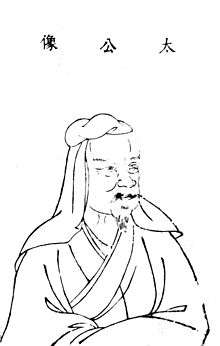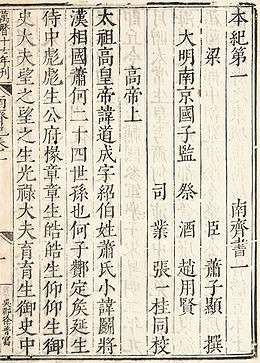List of Chinese military texts
| Chinese military texts |
|---|
| Part of a series on |
| Political thought in ancient China |
|---|
 |
|
Dynasties |
Chinese military texts have existed ever since Chinese civilization was founded. China's armies have long benefited from this rich strategic tradition, influenced by texts such as Sun Tzu's The Art of War, that have deeply influenced military thought.[1] Although traditional Chinese Confucian philosophy favoured peaceful political solutions and showed contempt for brute military force, the military was influential in most Chinese states. The works of well known strategists such as Sun Tzu and Sun Bin have heavily influenced military philosophy, warfare, and political discourse throughout China's long history. Works such as The Art of War have also found a strong following around the world, where they have influenced people as far ranging as the Chinese Communist Party and the former Secretary of Defense Donald Rumsfeld.[2]
Overview
The most well known of these military texts are the Seven Military Classics. The texts were canonized under this name during the 11th century AD, and from the Song Dynasty onwards were included in most military encyclopedias.[3] For imperial officers, either some or all of the works were required reading to merit promotion, analogous to the requirement for all bureaucrats to study and become familiar with Confucius' work. There were many anthologies with different notations and analyses by scholars throughout the centuries leading up to the present versions in Western publishing. Members of the Communist Party of China also studied the texts during the Chinese Civil War as well as many European and American military minds.[3]
Usage
The table's columns (except for Content and Images) are sortable by pressing the relevant arrows symbols. The following gives an overview of what is included in the table and how the sorting works.
- Name: the name as traditionally used by scholars
- Author: name of the author(s)
- Content: brief overview of the military text and its content
- Dynasty: dynasty or time period
- Date: year; The column entries sort by year
- Origin: the state from which the text originated from, this applies mainly to the Warring States period and the Spring and Autumn Period, when Chinese civilization was fractured into many independent kingdoms
- Image: picture of the document, an illustration from the document, a related document, or the alleged author of the document
- Description: a brief description of the image
Military Texts
Seven Military Classics
| Name | Authors | Content | Dynasty | Date | Origin | Image | Description |
|---|---|---|---|---|---|---|---|
| The Art of War (Chinese: 孫子兵法; pinyin: Sūnzǐ Bīngfǎ) | The Art of War is composed of 13 chapters, each of which is devoted to one aspect of warfare. Sun Tzu focuses on the importance of positioning in strategy and that position is affected both by objective conditions in the physical environment and the subjective opinions of competitive actors in that environment. | Spring and Autumn period (possibly the Warring States period.[4]) ) | unknown, ca. 6th century BC | State of Wu |  |
The beginning of The Art of War, in a "classical" bamboo book from the reign of the Qianlong Emperor. | |
| The Methods of the Sima (Chinese: 司馬法; pinyin: Sīmă Fă) | A text discussing laws, regulations, government policies, military organization, military administration, discipline, basic values, grand strategy, and strategy.[5] | Warring States period | 4th century BC | State of Qi | - |
- | |
| Six Secret Strategic Teachings (Chinese: 六韬; pinyin: Liùtāo) | A treatise on military strategy divided into six chapters, six types of ways to engage in war. | Zhou Dynasty | 11th century BC | State of Zhou (modern day Shaanxi) |  |
Portrait of Jiang Ziya from the Sancai Tuhui. | |
| Wei Liaozi (Chinese: 尉繚子; pinyin: Wèi Liáozi) | Wei Liao |
A treatise that advocates both a civil and military approach to affairs. It advocates emphasis on agriculture and people as the two greatest resources of the state. The text centers around a government based on humanistic values, with the ruler as the paradigm of virtue in the state. Heterodoxy and other values not conducive to the state should be punished using draconian measures.[6] | Warring States period [3] | 4th–3rd century BC [3] | State of Qin | - |
- |
| Three Strategies of Huang Shigong (Chinese: 黄石公三略; pinyin: Huáng Shígōng Sān Lǜe) | Unknown; attributed to Jiang Ziya and various other authors | The treastise is organized into three sections, which can be interpreted as a hierarchy of importance or as simple indicators of position in the work. The work itself states that all three types of strategy are necessary for different styles of government. Much of the work is concerned with administrative control, but some important tactical concepts are also developed. Generals are placed in a high position, and must be unquestioned once they assume command. Attacks should be swift and decisive.[7] | Warring States period [3] | Unknown; attributed to various time periods | Unknown; attributed to various origins | - |
- |
| Questions and Replies between Tang Taizong and Li Weigong (Chinese: 唐太宗李 衛 公 問 對; pinyin: Táng Tàizōng Lĭ wèigōng Wènduì) | A dialogue between Emperor Taizong of the Tang Dynasty and Li Jing, a prominent general of that dynasty. It discusses matters of military strategy.[3] | Tang Dynasty [3] | 7th century | State of Tang |  |
A painting portraying Tang Taizong by painter Yan Liben | |
Others
| Name | Authors | Content | Dynasty | Date | Origin | Image | Description |
|---|---|---|---|---|---|---|---|
| Sun Bin's Art of War (Chinese: 孫臏兵法; pinyin: Sūnbìn Bīngfă) | The treastise contains an extensive 89 chapters, with four volumes of pictures attached. | Warring States period. | 4th century BC | Qi state | - |
- | |
| Thirty-Six Stratagems (Chinese: 三十六計; pinyin: Sānshíliù Jì) | Unknown; attributed to various [8] |
A text used to illustrate a series of stratagems used in politics, war, as well as in civil interaction, often through unorthodox or deceptive means | Unknown; attributed to various | Unknown; attributed to various | Unknown; attributed to various |  |
A page from a Ming Dynasty edition of the Book of Qi, from which the name of the Thirty-Six Stratagems comes from. |
| Wujing Zongyao (Chinese: 武經總要; pinyin: Wǔjīng Zǒngyào; Wade–Giles: Wu Ching Tsung Yao; literally: "Collection of the Most Important Military Techniques") | Zeng Gongliang (曾公亮), Ding Du (丁度), and Yang Weide (楊惟德) |
The text is a Chinese military compendium, covering a wide range of subjects, everything from naval warships to different types of catapults. | Northern Song Dynasty | 1044 AD | Northern Song state |  |
An illustration of the Wujing Zongyao showing a Chinese Song Dynasty naval river ship with a Xuanfeng traction-trebuchet catapult on its top deck. |
| Huolongjing (simplified Chinese: 火龙经; traditional Chinese: 火龍經; pinyin: Huǒ Lóng Jīng Wade-Giles: Huo Lung Ching) | A treastise that outlines the use of various 'fire–weapons' involving the use of gunpowder. It discusses various gunpowder compositions, bombs, fire arrows, rocket launchers, land mines, naval mines, proto–guns, fire lances, bombards and cannons.[9] | Ming Dynasty | 14th century | Ming state |  |
Huolongjing depicting the 'Flying Crow with Magic Fire', an aerodynamic winged rocket bomb. | |
| Jixiao Xinshu (Chinese: 紀效新書) | Qi Jiguang (戚繼光) |
A text in which Qi Jiguang writes about strategy, armed and unarmed fighting and many other aspects of warfare. | Ming Dynasty | 16th century | Ming state |  |
Painting of Qi Jiguang, author of Jixiao Xinshu. |
| The General's Garden (simplified Chinese: 将苑; traditional Chinese: 將苑; pinyin: Jiàng Yuàn) | Zhuge Liang (諸葛亮) |
A short text plagiarising earlier military treatises, falsely attributed to Zhuge Liang. | Song Dynasty | 12th century | Song state |  |
Part of a 12th-century manuscript scroll of the Tangut translation of The General's Garden . |
References
- ↑ Griffith (2006), 1
- ↑ Hwang, Ching Chane. "Gender and Global Politics of the Asia-Pacific." MacMillan Publishers. p. 59.
- 1 2 3 4 5 6 7 Van de Ven, Hans J. (2000). Warfare in Chinese History. BRILL. p. 7. ISBN 90-04-11774-1.
- ↑ Griffith, Illustrated Art of War, p. 17-18
- ↑ Sawyer, Ralph D.; Mei Mei-chün Sawyer (1993). The Seven Military Classics of Ancient China. Westview Press. pp. 111–112. ISBN 0-8133-1228-0.
- ↑ Sawyer (1993) pp. 232–238
- ↑ Sawyer (1993) pp. 289–291
- ↑ "Exploring the Thirty-Six Strategies (Simplified Chinese)". Chinese Strategic Science Network. 2006-07-11. External link in
|publisher=(help) - ↑ Needham, Volume 5, Part 7.
Sources
- Sun, Tzu, The Art of War, Translated by Sam B. Griffith (2006), Blue Heron Books, ISBN 1-897035-35-7
- Needham, Joseph (1986). Science and Civilization in China: Volume 5, Chemistry and Chemical Technology, Part 7, Military Technology; the Gunpowder Epic. Taipei: Caves Books Ltd.